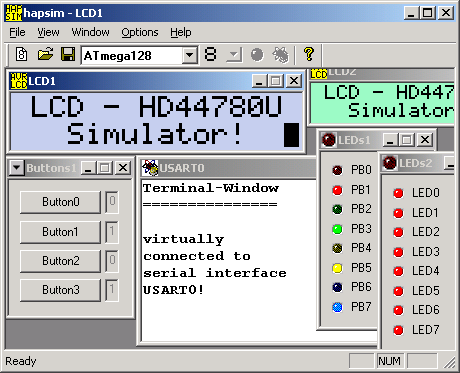LCD displej
Zo stránky SensorWiki
Programovateľný LCD displej
LCD Modul
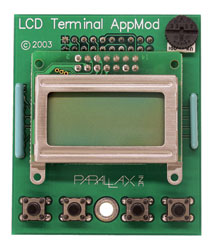
Vlastnosti:
- 2x8 LCD Displej bez podsvetlenia
- 4 Tlačítka
- Trimer na zmenu kontrastu
Technické parametre:
- Napájanie: 5 V @ 15 mA
- Pripojenie: 4-Bit parallel interface (Hitachi HD44780 compatible)
- Rozmery: 60 x 50 x 20 mm
- Pracovná teplota: 0 až +70 °C
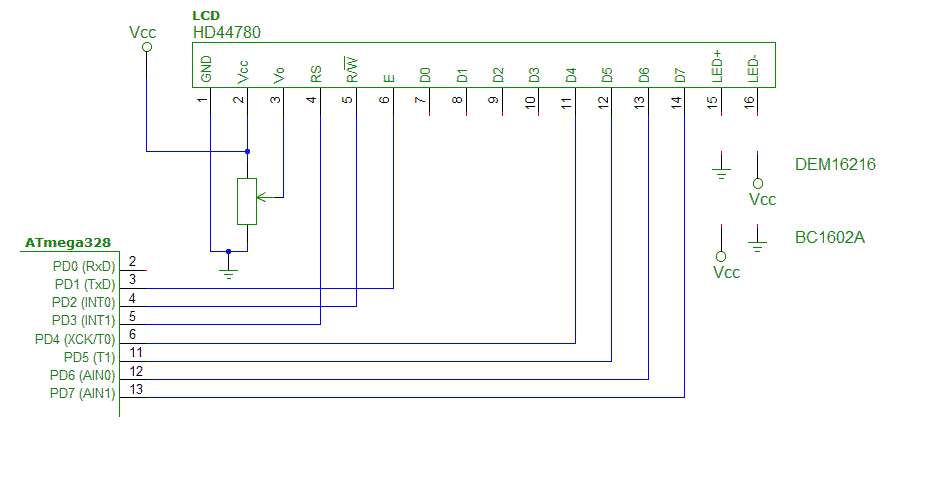
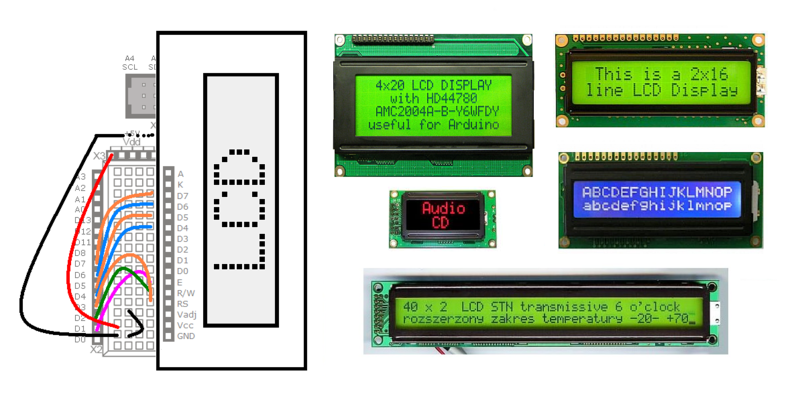
Úlohy
Najprv sa snažte pochopiť, ako je vytvorený vzorový program, ako sa konfiguruje pripojenie LCD k portom, skontrolujte konfiguráciu. Potom s pomocou manuálu k displeju zobrazte na displeji nejaký text a zrealizujte nasledovné funkcie:
- posun kurzora doprava / dolava
- posun obsahu displeja doprava / dolava
- napíšte funkciu void lcdGotoXY(riadok, stlpec)
- clear displeja (a obnovenie povodneho obsahu displeja)
- zadefinujte si vlastné znaky a zobrazte ich spolu s iným textom. Povinne aspoň jeden znak s diakritikou a znak stupeň, zobrazte teplotu.
Software
K dispozícii máte:
- Demo - skompilovanú ukážku možností práce s displejom.
- Knižnicu (lcd.c, lcd.h) s fungujúcou inicializáciou displeja a príkazmi na ovládanie.
- Pripravené sú funkcie:
.
void lcdInit4(void); // inicializácia displeja 4-bitovo
void lcdDataWrite(unsigned char w_data) ; // zapíše znak na aktuálnu pozíciu
void lcdControlWrite(unsigned char c_data); // zapíše príkaz do displeja
- Demonštračný program využívajúci tieto funkcie
.
#include "lcd.h"
int main(void)
{
unsigned char znak;
lcdInit4(); // inicializacia v 4-bitovom rezime
lcdControlWrite(1<<LCD_CLR); // display clear
lcdControlWrite(0x40); // pozicia 0,0
for(znak='A';znak<'I';znak++)
lcdDataWrite(znak); // vypis znaky ABCDEFGH
lcdControlWrite(0x40+0x80); // pozicia 1,0
for(znak='0';znak<'8';znak++)
lcdDataWrite(znak); // vypis znaky 01234567
for(;;);
return 0;
}
Ponz.: Ak pri vám kompilátor vypíše nasledovný Warning
c:/winavr-20080610/lib/gcc/../../avr/include/util/delay.h:85:3: warning: #warning "F_CPU not defined for <util/delay.h>"
znamená to, že nemáte nastavenú frekvenciu oscilátora a teda nie je možné preložiť knižnicu na generovanie oneskorenia. V menu Project -> Configuration Options nastavte Frequency na hodnotu 16000000 Hz.
Literatúra
- Katalógové listy
- Radič Hitachi HD44780
- Displej 2x16 DEM 16216 SYH-LY
- Displej 2x16 DEM 20231 SYH-PY
- 2x16 Parallel LCD datasheet
- Podrobné manuály sú aj u výrobcu Hantronix.
- Peter Ouwehand: How to control a HD44780-based Character-LCD
- Ian Harries: HD44780-Based LCD Modules'
- Tomáš Dresler: Inteligentní displeje a jejich připojení k PC. [hw.cz]
- Nuts & Volts: Demystifying Character Based LCDs
- Stamp Works - pp. 73 and more [1]
Arduino
Nasledovný príklad je pre Arduino.
/*
LiquidCrystal Library - Hello World
Demonstrates the use a 8x2 LCD display.
The circuit:
* LCD RS pin to digital pin 3
* LCD R/W pin to digital pin 2
* LCD Enable pin to digital pin 1
* LCD D4 pin to digital pin 4
* LCD D5 pin to digital pin 5
* LCD D6 pin to digital pin 6
* LCD D7 pin to digital pin 7
*/
#include <LiquidCrystal.h> // include the library
// initialize the library with the numbers of the interface pins
// LiquidCrystal(RS, RW, EN, D4, D5, D6, D7)
LiquidCrystal lcd( 3, 2, 1, 4, 5, 6, 7);
void setup() {
// set up the LCD's number of columns and rows:
lcd.begin(8, 2);
// Print a message to the LCD.
lcd.print("Ahoj!");
}
void loop() {
// set the cursor to column 0, line 1
// (note: line 1 is the second row, since counting begins with 0):
lcd.setCursor(0, 1);
// print the number of seconds since reset:
lcd.print(millis()/1000);
// print the status of buttons:
lcd.setCursor(6, 0);
lcd.print(ReadButtons(),HEX);
}
/* ------------------------------------------------------- */
/* Read and debounce the LCD AppMod buttons */
/* */
/* Returns 0 if nothing is pressed */
/* Returns 1 if button A is pressed */
/* Returns 2 if button B is pressed */
/* Returns 4 if button C is pressed */
/* Returns 8 if button D is pressed */
/* Returns combination if more is pressed (e.g. 6 for B+C)*/
/* */
/* ------------------------------------------------------- */
unsigned char ReadButtons()
{
DDRD = 0b00001110; // make LCD bus inputs
unsigned char state = 0xFF; // assume nothing pressed
for(int scan = 1; scan<=10; scan++)
{
state = state & ((PIND&0xF0)>>4); // make sure button held
delay(5); // debounce 10 x 5 ms
}
DDRD = 0b11111110; // return bus to outputs
return(state);
}
Misc:
Tlačítka modulu LCD Terminal AppMod
K maticovej klávesnici je aj tu https://learn.sparkfun.com/tutorials/sx1509-io-expander-breakout-hookup-guide/example-button-matrices pekný príklad.
Pre prístup k tlačítkam tohto modulu je v knižnici lcd.h k dispozícii funkcia
unsigned char ReadButtons();
Ak ju tam nemáte, tu je:
/* ------------------------------------------------------- */
/* Read and debounce the LCD AppMod buttons */
/* */
/* Returns 0 if nothing is pressed */
/* Returns 1 if button A is pressed */
/* Returns 2 if button B is pressed */
/* Returns 4 if button C is pressed */
/* Returns 8 if button D is pressed */
/* Returns combination if more is pressed (e.g. 6 for B+C)*/
/* */
/* ------------------------------------------------------- */
unsigned char ReadButtons()
{
DDRD = 0b00001110; // make LCD bus inputs
unsigned char state = 0xFF; // assume nothing pressed
for(int scan = 1; scan<=10; scan++)
{
state = state & ((PIND&0xF0)>>4); // make sure button held
_delay_ms(5); // debounce 10 x 5 ms
}
DDRD = 0b11111110; // return bus to outputs
return(state);
}
Prečo je takto napísaná a ako vlastne funguje lepšie zistíte, keď si preštudujete schému zapojenia:
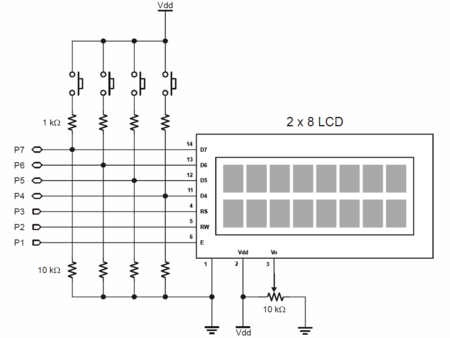
Simulátor periférií
Stiahnite a nainštalujte si Hapsim - simulátor periférií pre AVR Studio:
